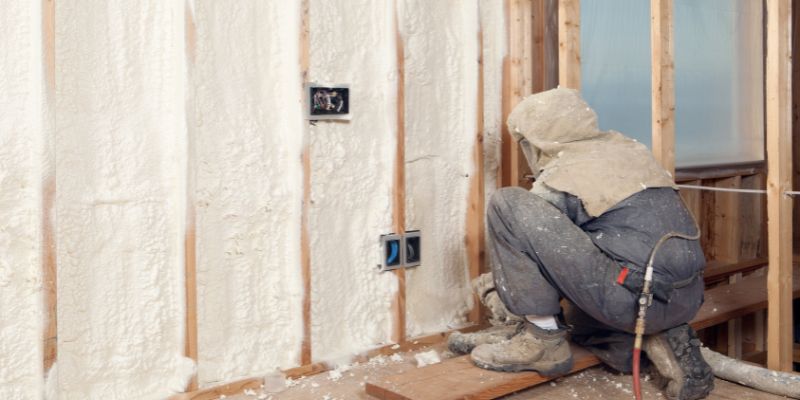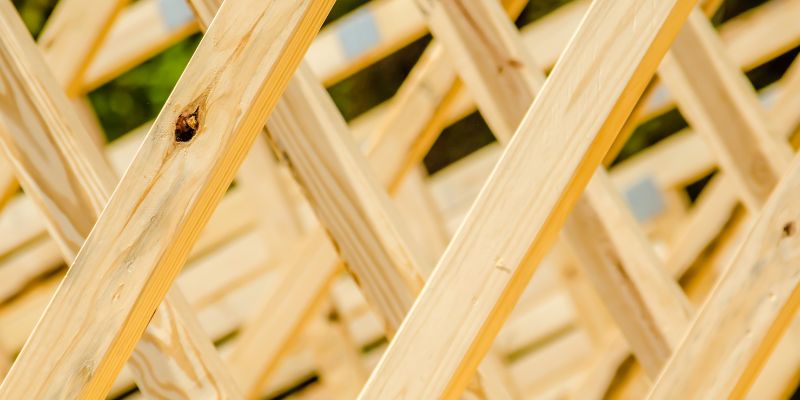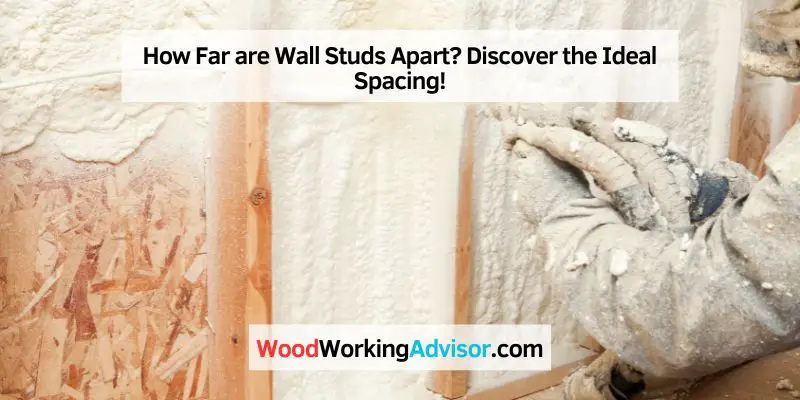Wall studs are typically spaced 16 or 24 inches apart. To ensure the structural integrity of a wall and proper installation of drywall or other wall materials, it is important to accurately locate and measure the spacing between wall studs.
Why Wall Stud Spacing Matters
When it comes to constructing sturdy walls, one important factor that often gets overlooked is the spacing between wall studs. Proper wall stud spacing is crucial for ensuring the overall strength and stability of a wall. In this article, we will delve into the significance of stud spacing, its impact on wall strength, and why it matters in the overall construction process.
Importance Of Stud Spacing
Did you know that the spacing between wall studs directly affects the structural integrity of a wall? It plays a vital role in supporting the weight of the wall and any load it carries. Stud spacing largely determines how well the wall resists the pressure exerted on it, whether it’s from gravity, wind, or even hanging items on the wall. With inadequate stud spacing, the wall may be prone to sagging, bowing, or even collapsing under substantial weight or external forces.
Impact On Wall Strength
The way wall studs are spaced significantly impacts the overall strength of a wall. By properly spacing the studs, the load is distributed evenly across the wall, allowing it to bear more weight without compromising its integrity. On the other hand, incorrect stud spacing can weaken the wall, leaving it susceptible to structural failures and potential damage.
To fully grasp the importance of stud spacing, let’s consider the analogy of the human skeletal system. Just as our bones provide support and structure to our bodies, wall studs serve as the foundational framework of a wall system. It’s vital to ensure that these supports are correctly spaced to maintain the wall’s ability to withstand the stresses it may face over time.
In addition to their crucial role in supporting the wall, properly spaced studs also facilitate the installation of various wall materials, such as drywall or insulation. Studs located too far apart can make it challenging to secure these materials firmly, resulting in a less stable and effective wall system.
Overall, the right stud spacing contributes to a structurally sound wall that is capable of withstanding everyday pressures and maintaining its longevity. It serves as the backbone of any well-built wall, ensuring its strength and stability for years to come.

Standard Wall Stud Spacing
Standard wall stud spacing typically ranges between 16 and 24 inches apart, but 16 inches in the center is the most common. This measurement ensures proper support for drywall and other wall materials. It’s important to adhere to local building codes and requirements when determining the spacing for wall studs.
When it comes to constructing walls, it is crucial to ensure the proper placement of wall studs. These vertical supports provide the structure and stability needed to bear the weight and distribute the loads of various building elements, such as drywall and cabinets. One significant factor to consider during wall construction is the spacing of the wall studs.
Common Spacing Measurements
The standard wall stud spacing can vary based on several factors, including building codes, wall height, and the materials used. However, there are some common spacing measurements that are widely followed in construction practices:
In general, standard wall studs are placed approximately 16 inches apart. This measurement is known as “16-inch on-center” (OC) spacing. Another spacing measurement commonly used is 24 inches apart, known as “24-inch on-center” (OC) spacing. These are considered the two most common spacing measurements for wall studs.
Factors Affecting Spacing
Several factors can influence the spacing of wall studs:
- Building codes: Local building codes outline minimum requirements for wall stud spacing. These codes ensure structural integrity and safe construction practices. It is essential to consult the applicable building codes to determine the required stud spacing for your specific project.
- Wall height: The height of the wall plays a crucial role in determining the spacing between studs. Taller walls may require closer stud spacing to provide adequate support and prevent bowing or sagging.
- Material used: The type of material used for the wall, such as wood or metal studs, can also affect the spacing. Wood studs are commonly spaced at 16 or 24 inches, while metal studs may have different spacing requirements depending on their gauge and the load-bearing capacity needed.
- Structural requirements: Certain areas of a wall, such as corners, openings for doors or windows, or sections where heavy fixtures will be installed, may require closer stud spacing to ensure proper support and load distribution.
Considering these factors and adhering to the recommended spacing measurements for wall studs is critical for constructing sturdy and durable walls that meet building code requirements. It is always recommended to consult with a qualified professional or building inspector to determine the appropriate wall stud spacing for your specific project.
Optimal Wall Stud Spacing
Wall stud spacing plays a crucial role in the structural integrity and stability of your walls. The distance between wall studs is an important consideration when it comes to ensuring the strength and durability of your walls. Understanding the optimal wall stud spacing is essential for a successful construction or renovation project.
Ensuring Structural Integrity
The correct spacing between wall studs is vital for ensuring structural integrity. Wall studs spaced too far apart can result in a weaker and less stable wall, potentially leading to issues such as drywall cracks and sagging. Optimal wall stud spacing ensures the structural integrity of the wall, providing adequate support for the weight of the building and its contents.
Enhancing Wall Stability
Proper spacing between wall studs is essential for enhancing wall stability. Wall stud spacing that is too wide can compromise the wall’s ability to withstand external forces, such as wind or seismic activity. Optimal wall stud spacing helps to enhance the stability of the wall, providing a solid framework for attaching finishes and ensuring the overall sturdiness of the structure.
Determining Stud Spacing For Different Walls
When it comes to building or remodeling a home, it is important to understand the importance of stud spacing. Wall studs are vertical 2×4 or 2×6 timber pieces that provide support for your walls. Proper stud spacing ensures stability and allows for secure anchoring of fixtures and fittings to the walls. The standard measurement for stud spacing is typically 16 inches in the center. However, there can be variations depending on the type of wall.
Interior Walls
Interior walls are the walls that separate rooms within your home. They do not face the exterior of the house. Stud spacing for interior walls is generally the same as the standard measurement of 16 inches on the center. This standard spacing provides adequate stability and support for various wall materials such as drywall, paneling, or plaster. It also ensures that hanging shelves, cabinets, or other fixtures on these walls will be securely fastened.
Exterior Walls
Exterior walls, on the other hand, are the walls that face the outside of your home and protect it from the elements. These walls require stronger support due to the additional weight and forces they are subjected to. Stud spacing for exterior walls is typically closer together than interior walls, often measuring 12 inches in the center. This closer spacing ensures the walls have the necessary strength and rigidity to withstand external elements like wind, rain, and snow loads.
Summary:
- Interior walls typically have stud spacing of 16 inches in the center.
- Exterior walls usually have stud spacing of 12 inches in the center.
- Proper stud spacing ensures stability and secure attachment of fixtures and fittings to the walls.
- Stud spacing may vary depending on the type of wall, with interior and exterior walls having different spacing measurements.
In conclusion, understanding the appropriate stud spacing for different types of walls is crucial for ensuring the stability and strength of your home. By adhering to the standard measurements, you can confidently hang shelves, mount televisions, or install cabinets without worrying about compromising the integrity of your walls. Whether it’s an interior wall or an exterior wall, ensuring proper stud spacing will help you create a sturdy and durable living space.
Practical Considerations For Stud Spacing
When it comes to constructing or renovating a wall, one important factor to consider is the spacing between wall studs. Wall studs play a crucial role in providing structural support and stability to your walls; therefore, properly spaced studs are essential to ensure the integrity and strength of your construction. In this section, we will discuss the practical considerations for stud spacing, including the influence of building codes and the impact on the installation of wall fixtures.
Influence Of Building Codes
Building codes are regulations set by local authorities or organizations to ensure that structures are safe, durable, and up to certain standards. These codes often dictate the guidelines for wall stud spacing to maintain the structural integrity of walls. It’s crucial to adhere to these codes to avoid potential safety hazards and ensure compliance with the local building regulations.
Impact On Installation Of Wall Fixtures
The spacing between wall studs can also have a significant impact on the installation of various wall fixtures, such as shelves, cabinets, or TV mounts. If the stud spacing doesn’t align with the fixture’s mounting requirements, it can make the installation process challenging and compromise the stability of the fixture. Therefore, it is essential to consider stud spacing while planning the layout of your wall fixtures to ensure secure and hassle-free installation.
Moreover, by having knowledge of the stud spacing in advance, you can easily determine the precise location to hang pictures, mirrors, or decorative items. This knowledge eliminates the guesswork and helps you save time when it comes to hanging objects on the wall.
In addition, understanding stud spacing can also influence the design possibilities for your walls. For example, if you know the exact placement of wall studs, you can plan your interior decor in a way that maximizes the available space and avoids any potential obstructions caused by studs.

Frequently Asked Questions Of How Far Are Wall Studs Apart
Are Studs Every 12 Inches Apart?
Studs are typically placed every 16 inches apart, not 12 inches.
How Do I Find A Stud In My Wall?
To find a stud in your wall, use a stud finder or knock on the wall to listen for a solid sound. You can also look for electrical outlets or switches, as they are often anchored to studs. Use a small nail to confirm the location of the stud once found.
How Do You Know If You Hit A Stud?
A stud finder helps locate studs in the wall. Tap the wall until you hear a solid, rather than a hollow, sound. You may also use a magnet or a stud finder tool to confirm the presence of a stud.
How Far Apart Are 2×4 Studs In A Wall?
2×4 studs in a wall are typically spaced 16 inches apart, center to center.
Conclusion
Determining the spacing between wall studs is crucial for various home improvement projects. Understanding stud placement plays a vital role in ensuring the structural integrity of your walls. With the right tools and techniques, you can accurately locate and measure studs.
By following the methods outlined in this post, you can confidently complete your projects with precision.


